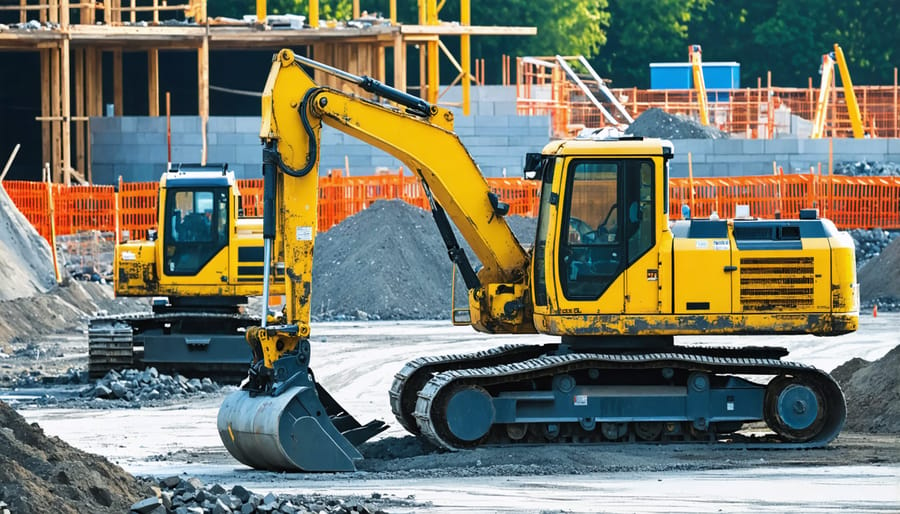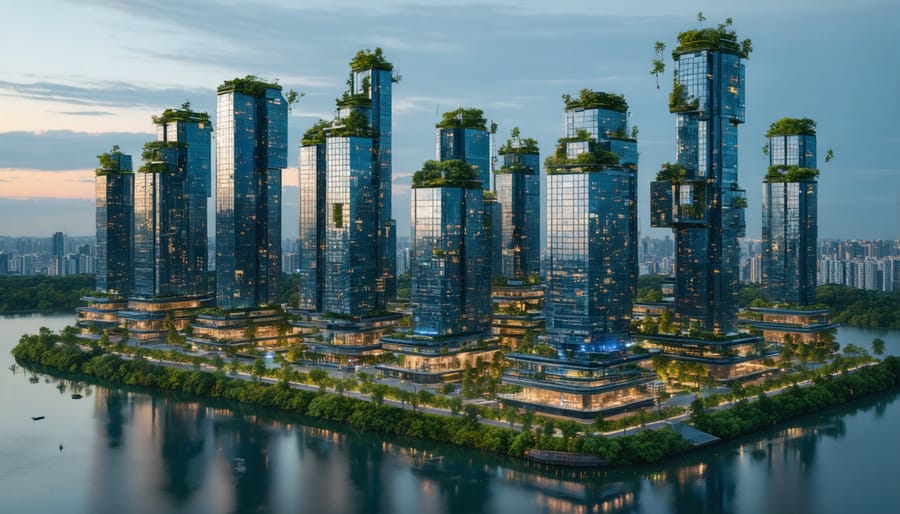The global construction and remodeling sector stands at a pivotal crossroads, where technological innovation meets unprecedented market demands. With projected industry growth reaching $15.2 trillion by 2030, construction firms worldwide are revolutionizing their approaches through digital transformation, sustainable practices, and innovative building methodologies. The convergence of smart technologies, environmental imperatives, and shifting consumer preferences has created a dynamic landscape where traditional construction methods merge with cutting-edge solutions.
From AI-powered project management systems to carbon-neutral building materials, the industry’s evolution reflects a fundamental shift in how we conceive, execute, and deliver construction projects. This transformation extends beyond mere structural improvements to encompass comprehensive solutions that address climate change, urbanization challenges, and resource efficiency. Leading firms are adopting integrated digital platforms, implementing modular construction techniques, and embracing sustainable practices to meet evolving global standards and client expectations.
As emerging markets drive construction demand and developed regions focus on infrastructure renewal, the industry faces both unprecedented opportunities and complex challenges. Success in this evolving landscape requires a strategic balance of technological adoption, sustainable practices, and operational efficiency, positioning companies to thrive in an increasingly competitive global market.
Sustainable Building Practices Take Center Stage
Net-Zero Construction Innovation
The construction industry is rapidly evolving towards carbon neutrality, with pioneering sustainable building innovations reshaping traditional practices. Leading firms are implementing mass timber construction techniques, which not only reduce carbon emissions but also serve as carbon sinks. Advanced building envelope systems, featuring dynamic glazing and high-performance insulation materials, are dramatically improving energy efficiency while maintaining optimal indoor environments.
Cutting-edge carbon-capture technologies are being integrated into building materials, particularly in concrete production. These innovative concrete formulations can absorb CO2 throughout their lifecycle, effectively turning structures into carbon-negative assets. Additionally, modular construction methods are gaining traction, reducing waste and transportation emissions while ensuring precise quality control.
Energy systems in net-zero buildings now commonly incorporate AI-driven smart grid integration, on-site renewable energy generation, and advanced energy storage solutions. These systems work in concert with building management platforms to optimize energy consumption in real-time.
Recent case studies demonstrate that net-zero construction can be commercially viable. The Edge building in Amsterdam, for instance, achieves 102% energy efficiency through solar panels, rainwater harvesting, and advanced automation. Such examples prove that carbon-neutral construction isn’t just environmentally responsible – it’s increasingly becoming a sound business decision that drives long-term value and operational efficiency.

Circular Economy in Construction
The construction industry is increasingly embracing circular economy principles to address mounting environmental concerns and resource scarcity. Material recycling and waste reduction have become paramount, with leading construction firms implementing comprehensive waste management strategies that typically achieve 80-90% waste diversion rates from landfills.
Construction and demolition waste (C&D) recycling has evolved beyond basic material sorting. Advanced processing facilities now transform concrete debris into high-quality aggregates for new construction, while reclaimed wood finds new life in architectural elements and furniture. Steel, which maintains its structural properties through multiple recycling cycles, demonstrates a particularly successful circular model, with recycled content in construction steel averaging 93% globally.
Innovative waste reduction strategies include Building Information Modeling (BIM) for precise material quantity calculations, prefabrication to minimize on-site waste, and design for deconstruction (DfD) principles that facilitate future material recovery. Leading contractors are implementing closed-loop material tracking systems, ensuring materials are either reused on-site or redirected to appropriate recycling streams.
Case studies from major projects demonstrate the economic viability of circular practices. The renovation of London’s Olympic Park achieved a 99% waste recovery rate, while Singapore’s construction sector has pioneered a mandatory waste reporting system that has reduced disposal costs by 23% industry-wide. These successes highlight how circular economy principles can deliver both environmental and financial benefits in construction operations.
Technology Reshaping Construction Methods
Digital Twin Technology
Digital twin technology has revolutionized the construction industry by creating virtual replicas of physical buildings and infrastructure, enabling unprecedented levels of project visualization and management. These advanced 3D models integrate real-time data from sensors, building management systems, and IoT devices to provide dynamic representations of construction projects throughout their lifecycle.
In project planning, digital twins enable stakeholders to simulate various scenarios and identify potential challenges before breaking ground. Construction teams can optimize building designs, test different materials, and analyze structural performance in virtual environments, significantly reducing costly modifications during construction. For example, Turner Construction implemented digital twin technology in a recent hospital project, resulting in a 30% reduction in design conflicts and a 25% improvement in project delivery time.
The technology’s impact extends beyond the planning phase. During construction, digital twins facilitate real-time monitoring of progress, resource allocation, and safety compliance. Project managers can track construction sequences, coordinate subcontractors, and maintain quality control through continuous comparison between the virtual model and actual construction.
For existing structures, digital twins support efficient facility management and renovation planning. Building operators can monitor performance metrics, predict maintenance needs, and simulate renovation scenarios without disrupting ongoing operations. The technology has proven particularly valuable in complex retrofitting projects, where accurate documentation of existing conditions is crucial.
According to industry experts, digital twin adoption is expected to grow by 35% annually over the next five years. This growth is driven by improved cost-effectiveness, enhanced collaboration capabilities, and the increasing demand for smart building solutions. As the technology continues to evolve, it promises to further streamline construction processes and improve project outcomes across the global construction sector.

AI and Automation in Construction
Artificial intelligence and automation are revolutionizing construction processes, offering unprecedented improvements in efficiency, safety, and precision. Machine learning algorithms now optimize project scheduling and resource allocation, while AI-powered analytics predict potential construction risks and maintenance needs with remarkable accuracy.
Robotics applications have evolved from simple repetitive tasks to complex operations. Construction sites increasingly employ autonomous equipment for tasks like bricklaying, welding, and concrete work. For instance, SAM (Semi-Automated Mason) can lay up to 3,000 bricks per day, significantly outperforming traditional methods while maintaining consistent quality.
Computer vision and drone technology enable real-time project monitoring and inspection, creating detailed 3D models and identifying potential issues before they become costly problems. AI systems analyze these data streams to ensure construction adheres to design specifications and safety standards.
Prefabrication processes have been enhanced through automation, with robotic systems manufacturing building components in controlled environments. This approach reduces on-site construction time, minimizes waste, and ensures higher quality control standards.
Project management has been transformed through AI-driven platforms that optimize workflow coordination and resource management. These systems analyze historical project data, weather patterns, and supply chain variables to make informed decisions and prevent delays.
Despite these advances, human expertise remains crucial. Construction professionals now focus more on strategic decision-making and complex problem-solving while automated systems handle routine tasks. The key to successful implementation lies in finding the right balance between human insight and technological capability.
Looking ahead, the integration of AI and automation is expected to accelerate, with emerging technologies like autonomous construction vehicles and AI-designed buildings becoming increasingly common. Companies that embrace these innovations while maintaining strong human oversight will likely gain significant competitive advantages in the evolving construction landscape.

Regional Market Dynamics
Emerging Markets Growth
The rapid expansion of emerging construction markets continues to reshape the global building landscape, with regions like Southeast Asia, Latin America, and Africa experiencing unprecedented growth. Infrastructure development in these markets is projected to exceed $5.6 trillion by 2025, presenting substantial opportunities for international contractors and investors.
Countries like India, Vietnam, and Indonesia are leading this transformation through ambitious urban development initiatives and expanding middle-class populations. These demographics are driving demand for both residential and commercial construction, while government-backed infrastructure projects create additional momentum for industry growth.
Notable trends include the adoption of public-private partnership (PPP) models, particularly in transportation and energy infrastructure. For instance, Vietnam’s recent implementation of PPP frameworks has attracted over $12 billion in foreign investment for construction projects. Similarly, India’s Smart Cities Mission has catalyzed urban development across 100 cities, generating numerous opportunities for construction firms and technology providers.
However, success in these markets requires careful navigation of local regulations, building codes, and business practices. Companies must develop region-specific strategies that account for varying labor costs, material availability, and technological readiness. Strategic partnerships with local firms have proven essential for international companies seeking to establish a presence in these dynamic markets.
Mature Market Evolution
Established construction markets in North America, Western Europe, and Japan are undergoing significant transformations as they adapt to modern challenges and opportunities. These mature markets are shifting from traditional growth patterns focused on new construction towards a more balanced approach that emphasizes renovation, modernization, and adaptive reuse of existing structures.
A key characteristic of this evolution is the increasing focus on smart building technologies and sustainable retrofitting. Major metropolitan areas are seeing a surge in deep energy retrofits of commercial buildings, with property owners investing heavily in energy-efficient systems and digital infrastructure to meet stringent environmental regulations and tenant demands.
The renovation sector has become particularly dynamic, driven by aging infrastructure and changing demographic needs. In the United States alone, the remodeling industry has grown to represent over $400 billion annually, with a significant portion dedicated to commercial and institutional buildings.
Market maturity has also led to sophisticated project delivery methods, with integrated project delivery (IPD) and design-build approaches becoming increasingly prevalent. These methods emphasize collaboration, risk-sharing, and efficiency, resulting in better project outcomes and reduced costs.
Innovation in these markets is increasingly focused on solving specific challenges like labor shortages through automation and prefabrication, while also addressing sustainability goals through advanced materials and construction techniques. This evolution represents a shift from volume-based growth to value-based development, prioritizing quality, efficiency, and long-term sustainability.
Supply Chain Resilience
In today’s globalized construction industry, maintaining supply chain resilience has become critical for project success. Recent disruptions, from the global pandemic to geopolitical tensions, have highlighted the need for robust supply chain management strategies in construction and remodeling projects.
A key approach to strengthening supply chain resilience is diversification of suppliers. Leading construction firms now maintain relationships with multiple suppliers across different geographical regions, reducing dependency on single sources. This strategy has proven particularly effective in mitigating risks associated with material shortages and regional disruptions.
Digital supply chain management systems have emerged as essential tools for enhancing visibility and control. These platforms enable real-time tracking of materials, predictive analytics for potential disruptions, and automated inventory management. Construction companies implementing these systems report a 30% reduction in supply-related project delays and improved cost management.
Local sourcing has gained prominence as a complementary strategy to global procurement. By establishing relationships with local suppliers, construction firms can reduce transportation costs, decrease carbon footprint, and maintain better control over material quality. This hybrid approach of global and local sourcing provides flexibility during supply chain disruptions.
Risk assessment and contingency planning have become standard practices. Successful construction firms now regularly conduct supply chain vulnerability assessments and maintain detailed contingency plans for critical materials. These plans often include alternative suppliers, substitute materials, and buffer inventory strategies for essential components.
Strategic partnerships and long-term agreements with key suppliers have proven effective in ensuring material availability. Such relationships often include priority access arrangements, guaranteed supply volumes, and collaborative planning for future needs. Construction companies report that these partnerships have reduced procurement costs by up to 15% while improving supply reliability.
Storage and inventory management strategies have evolved to balance just-in-time delivery with supply security. Many firms now maintain strategic stockpiles of critical materials, using data analytics to optimize inventory levels without excessive carrying costs.
As we look ahead, global construction trends indicate a transformative period for the industry, driven by technological innovation, sustainability imperatives, and evolving market demands. The integration of digital solutions, including BIM technology and AI-powered project management tools, is becoming standard practice rather than optional advancement. Industry leaders are increasingly prioritizing sustainable building practices, with green construction methods and materials expected to dominate future projects.
The market outlook remains optimistic, despite challenges in supply chain management and material costs. Emerging markets, particularly in Asia and Africa, continue to present substantial growth opportunities, while developed regions focus on infrastructure renewal and sustainable urban development. The rise of modular construction and prefabrication techniques is reshaping project timelines and efficiency metrics across the sector.
Looking forward, the industry must address several critical challenges, including skilled labor shortages, regulatory compliance, and the need for greater digitalization. Success will depend on adapting to these changes while maintaining focus on quality, safety, and sustainability. Companies that embrace innovation, invest in workforce development, and prioritize sustainable practices will be best positioned to capitalize on future opportunities in the global construction and remodeling market.

